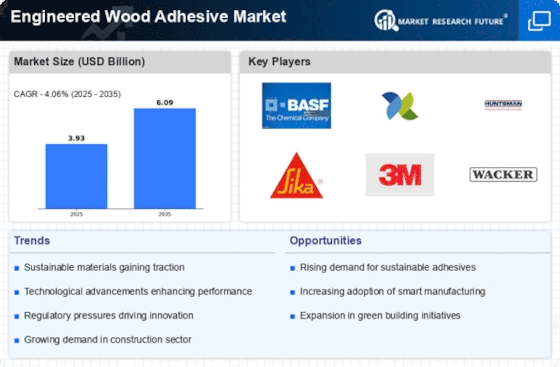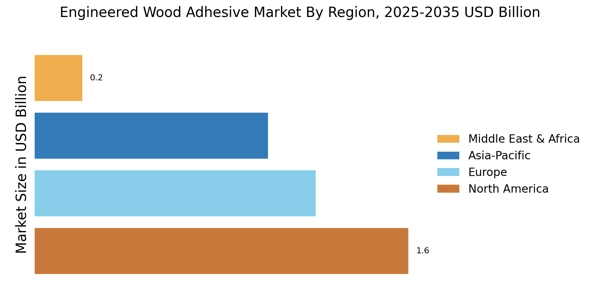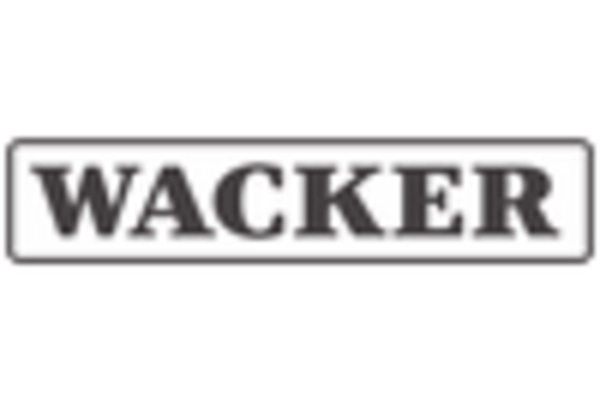Regulatory Compliance
Regulatory compliance regarding the use of adhesives in engineered wood products is becoming increasingly stringent, which may drive growth in the Engineered Wood Adhesive Market. Governments and regulatory bodies are implementing stricter guidelines to limit harmful substances in adhesives, particularly those that emit VOCs. This regulatory landscape compels manufacturers to innovate and reformulate their products to meet these standards, thereby creating opportunities for growth. Companies that proactively adapt to these regulations may gain a competitive advantage, as they can offer compliant products that appeal to environmentally conscious consumers. The Engineered Wood Adhesive Market is thus likely to see a shift towards more compliant and safer adhesive solutions, which could enhance overall market dynamics.
Technological Innovations
Technological advancements in adhesive formulations and application techniques are significantly influencing the Engineered Wood Adhesive Market. Innovations such as the development of water-based adhesives and advanced curing technologies are enhancing the performance and efficiency of engineered wood products. For instance, the introduction of adhesives that offer superior bonding strength and faster curing times is likely to improve production processes and reduce operational costs for manufacturers. Furthermore, the integration of automation in adhesive application is streamlining operations, thereby increasing productivity. As these technologies continue to evolve, they may provide manufacturers with a competitive edge, allowing them to meet the growing demand for high-quality engineered wood products. The Engineered Wood Adhesive Market is thus positioned to benefit from these advancements, which could lead to increased market penetration and expansion opportunities.
Sustainability Initiatives
The increasing emphasis on sustainability within the construction and furniture industries appears to be a primary driver for the Engineered Wood Adhesive Market. As consumers and manufacturers alike prioritize eco-friendly materials, the demand for adhesives that are low in volatile organic compounds (VOCs) and derived from renewable resources is likely to rise. This shift towards sustainable practices not only aligns with regulatory requirements but also caters to a growing consumer base that values environmental responsibility. Consequently, manufacturers are investing in research and development to create innovative adhesive solutions that meet these sustainability criteria, thereby enhancing their market position. The Engineered Wood Adhesive Market is thus witnessing a transformation, where eco-conscious products are becoming increasingly prevalent, potentially leading to a more competitive landscape.
Diversification of End-Use Applications
The diversification of applications for engineered wood products is emerging as a significant driver for the Engineered Wood Adhesive Market. As engineered wood finds its way into various sectors, including construction, furniture, and automotive, the demand for specialized adhesives tailored to these applications is likely to grow. For example, the construction sector increasingly utilizes engineered wood for structural applications, necessitating adhesives that can withstand varying environmental conditions. Additionally, the furniture industry is adopting engineered wood for its aesthetic and functional benefits, further driving the need for high-performance adhesives. This trend suggests that manufacturers may need to develop a broader range of adhesive products to cater to these diverse applications, potentially leading to increased market share and revenue growth within the Engineered Wood Adhesive Market.
Rising Demand for Engineered Wood Products
The rising demand for engineered wood products is a crucial driver for the Engineered Wood Adhesive Market. As consumers increasingly favor engineered wood for its durability, aesthetic appeal, and cost-effectiveness, the need for high-quality adhesives to bond these materials becomes paramount. Market data indicates that the engineered wood products segment is expected to witness substantial growth, with projections suggesting a compound annual growth rate (CAGR) of over 5% in the coming years. This trend is likely to stimulate demand for adhesives that can provide strong, lasting bonds while maintaining the integrity of the engineered wood. Consequently, manufacturers in the Engineered Wood Adhesive Market may need to scale up production and enhance their product offerings to meet this burgeoning demand, potentially leading to increased market competition.


















Leave a Comment